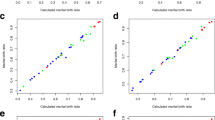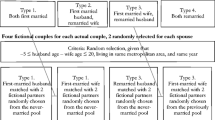Abstract
We merge census microdata with vital statistics data to examine the effect of women’s marriage opportunities on nonmarital fertility rates and ratios across 75 U.S. metropolitan areas. Measures of the quantity and “quality” of marriageable men simultaneously specific for women’s age, race, education, and place of residence reveal especially poor marriage prospects for highly educated black women. The effect of mate availability on nonmarital fertility is generally modest. Among white women, marriage opportunities are associated inversely with the nonmarital fertility rate, perhaps reflecting an increased likelihood that a premarital conception will be legitimated. Marriage opportunities also reduce nonmarital fertility ratios for young black and white women. The nonmarital fertility rate is lower among women whose marriage pool includes a large percentage of nonemployed males. Only a small proportion of the racial difference in nonmarital fertility appears attributable to differences in the marriage markets of black and of white women.
Similar content being viewed by others
References
Abrahamse, Allan, Peter Morrison, and Linda Waite. 1988. “Beyond Stereotypes: Who Becomes a Single Teenage Mother?” Paper R-3489-HHSINICHD. Santa Monica: RAND.
Becker, Gary S. 1974. “A Theory of Marriage.” Pp. 299–344 in Economics of the Family, edited by Theodore W. Schultz. Chicago: University of Chicago Press.
—. 1981. A Treatise on the Family. Cambridge, MA: Harvard University Press.
Bennett, Neil G., David E. Bloom, and Patricia H. Craig. 1989. “The Divergence of Black and White Marriage Patterns.” American Journal of Sociology 95:692–722.
Billy, John O.G., Karin L. Brewster, David E. Moore, and William R. Grady. 1989. “Contextual Influences on Premarital Sexual Behavior.” Paper presented at the annual meetings of the Population Association of America, Baltimore.
Billy, John O.G. and David E. Moore. 1991. “A Multilevel Analysis of Marital and Nonmarital Fertility in the U.S.” Paper presented at the annual meetings of the Population Association of America, Washington, DC.
Bumpass, Larry and Sara McLanahan. 1989. “Unmarried Motherhood: Recent Trends, Composition, and Black-White Differences.” Demography 26:279–86.
Cooksey, Elizabeth C. 1990. “Factors in the Resolution of Adolescent Premarital Pregnancies.” Demography 27:207–18.
Cox, Oliver C. 1940. “Sex Ratio and Marital Status among Negroes.” American Sociological Review 5:937–47.
Cutright, Phillips. 1971. “Illegitimacy: Myths, Causes, and Cures.” Family Planning Perspectives 3:26–48.
Darity. William A., Jr. and Samuel L. Myers Jr. 1984. “Does Welfare Dependency Cause Female Headship? The Case of the Black Family.” Journal of Marriage and the Family 46:765–79.
Duncan. Greg J. and Saul D. Hoffman. 1990. “Welfare Benefits, Economic Opportunities, and Out-Of-Wedlock Births among Black Teenage Girls.” Demography 27:519–35.
Ermisch, J. F. 1981. “Economic Opportunities, Marriage Squeezes, and the Propensity to Marry: An Economic Analysis of Period Marriage Rates in England and Wales.” Population Studies 35:347–56.
Espenshade, Thomas J. 1985. “Marriage Trends in America: Estimates, Indicators, and Underlying Causes.” Population and Development Review 11:193–245.
Farley, Reynolds. 1988. “After the Starting Line: Blacks and Women in an Uphill Race.” Demography 25:477–95.
Fossett, Mark A. and K. Jill Kiecolt. 1991a. “A Methodological Review of the Sex Ratio: Alternatives for Comparative Research.” Journal of Marriage and the Family 53:941–957.
Fossett, Mark A. and K. Jill Kiecolt. 1991b. “Mate Availability and Family Structure among African Americans in U.S. Metropolitan Areas.” Paper presented at the annual meetings of the American Sociological Association, Cincinnati.
Freiden, Alan. 1974. “The U.S. Marriage Market.” Pp. 352–71 in Economics of the Family, edited by Theodore W. Schultz. Chicago: University of Chicago Press.
Furstenberg, Frank F., Jr., S. Philip Morgan, Kristin A. Moore, and James L. Peterson. 1987. “Race Differences in the Timing of Adolescent Intercourse.” American Sociological Review 52:511–18.
Garfinkel, Irwin and Sara McLanahan. 1986. Single Mothers and Their Children. Washington, DC: Urban Institute Press.
Goldman, Noreen, Charles F. Westoff, and Charles Hammerslough. 1984. “Demography of the Marriage Market in the United States.” Population Index 50:5–25.
Goldscheider, Frances Kobrin and Linda J. Waite. 1986. “Sex Differences in the Entry into Marriage.” American Journal of Sociology 92:91–109.
Grossbard-Shechtman, Shoshana A. 1985a. “Marriage Squeezes and the Marriage Market.” pp. 375–95 in Contemporary Marriage: Comparative Perspectives on a Changing Institution, edited by Kingsley Davis. New York: Russell Sage.
Grossbard-Shechtman, Shoshana A. 1985b. “Sex Ratios, Marriage Markets, and Female Labor Force Participation.” Paper presented at the annual meetings of the Population Association of America, Boston.
Guttentag, Marcia and Paul F. Secord. 1983. Too Many Women? The Sex Ratio Question. Beverly Hills: Sage.
Hanson, Sandra, David Myers, and Alan Ginsburg. 1987. “The Role of Personality and Knowledge in Reducing Teenage Out-of-Wedlock Childbearing.” Journal of Marriage and the Family 49:241–56.
Heer, David M. and Amyra Grossbard-Shechtman, 1981. “The Impact of the Female Marriage Squeeze and the Contraceptive Revolution on Sex Roles and the Women’s Liberation Movement in the United States, 1960–1975.” Journal of Marriage and the Family 43:49–65.
Hogan, Dennis P. and Evelyn M. Kitagawa. 1985. “The Impact of Social Status, Family Structure, and Neighborhood on the Fertility of Black Adolescents.” American Journal of Sociology 90:825–55.
Hyle, Patricia Davis. 1989. “Nonmarital Adolescent Fertility: Variations across Metropolitan Areas of the United States.” Paper presented at the annual meetings of the Population Association of America, Baltimore.
Janowitz, Barbara S. 1976. “The Impact of AFDC on Illegitimate Birth Rates.” Journal of Marriage and the Family 38:485–94.
Leibowitz, Arleen, Marvin Eisen, and Winston K. Chow. 1986. “An Economic Model of Teenage Pregnancy Decision-Making.” Demography 23:67–77.
Lichter, Daniel T., Felicia B. LeClere, and Diane K. McLaughlin. 1991. “Local Marriage Market Conditions and the Marital Behavior of Black and White Women.” American Journal of Sociology 96:843–67.
Lloyd, Kim M. 1990. “Births to Single Women and the Male Marriage Pool: An Examination of Structural Effects on Black and White Populations.” Unpublished master’s thesis, Department of Sociology, Western Washington University.
Moore, Kristin A. and Steven B. Caldwell. 1977. “The Effect of Government Policies on Out-Of-Wedlock Sex and Pregnancy.” Family Planning Perspectives 9:164–69.
Nathanson, Constance A. and Young J. Kim. 1989. “Components of Change in Adolescent Fertility, 1971–1979.” Demography 26:85–98.
National Center for Health Statistics (NCHS). 1983a. Natality Data, Local Area Summary, 1980. [Machine-readable data file]. Hyattsville, MD: National Center for Health Statistics.
—. 1983b. Public Use Data Tape Documentation: 1981 Detail Natality. Hyattsville, MD: National Center for Health Statistics.
—. 1984. Natality Data, Local Area Summary, 1981. [Machine-readable data file]. Hyattsville, MD: National Center for Health Statistics.
O’Connell, Martin and Carolyn C. Rogers. 1984. “Out-Of-Wedlock Births, Premarital Pregnancies, and Their Effect on Family Formation and Dissolution.” Family Planning Perspectives 16:157–62.
O’Hare, William. 1988. “An Evaluation of Three Theories Regarding the Growth of Black Female-Headed Families.” Journal of Urban Affairs 10:183–97.
Oppenheimer, Valerie Kincade. 1988. “A Theory of Marriage Timing.” American Journal of Sociology 94:563–91.
Passel, Jeffrey S. and J. Gregory Robinson. 1984. “Factors Associated with Variation in Sex Ratios of the Population across States and MSAs: Findings Based on Regression Analysis of 1980 Census Data.” Paper presented at the annual meetings of the American Statistical Association, Philadelphia.
Plotnick, Robert D. 1988. “Determinants of Teenage Out-Of-Wedlock Childbearing: Evidence from the National Longitudinal Survey of Youth.” Paper presented at the annual meetings of the Population Association of America, New Orleans.
— 1990. “Welfare and Out-Of-Wedlock Childbearing: Evidence from the 1980s.” Journal of Marriage and the Family 52:735–46.
Preston, Samuel H. and Alan T. Richards. 1975. “The Influence of Women’s Work Opportunities on Marriage Rates.” Demography 12:207–22.
Rosenbaum, Emily and Denise B. Kandel. 1990. “Early Onset of Adolescent Sexual Behavior and Drug Involvement.” Journal of Marriage and the Family 52:783–98.
Schoen, Robert. 1983. “Measuring the Tightness of a Marriage Squeeze.” Demography 20:61–78.
Schoen, Robert and John Baj. 1985. “The Impact of the Marriage Squeeze in Five Western Countries.” Sociology and Social Research 70:8–20.
Schoen, Robert and James R. Kluegel. 1988. “The Widening Gap in Black and White Marriage Rates: The Impact of Population Composition and Differential Marriage Propensities.” American Sociological Review 53:895–907.
Schoen, Robert and John Wooldredge. 1989. “Marriage Choices in North Carolina and Virginia, 1969–71 and 1979–81.” Journal of Marriage and the Family 51:465–81.
Smith, Herbert L. and Phillips Cutright. 1988. “Thinking about Change in Illegitimacy Ratios: United States, 1963–1983.” Demography 25:235–47.
South, Scott J. 1988. “Sex Ratios, Economic Power, and Women’s Roles: A Theoretical Extension and Empirical Test.” Journal of Marriage and the Family 50:19–31.
South, Scott J. and Kim M. Lloyd. 1992. “Marriage Opportunities and Family Formation: Further Implications of Imbalanced Sex Ratios.” Journal of Marriage and the Family. 54:forthcoming.
South, Scott J. and Katherine Trent. 1988. “Sex Ratios and Women’s Roles: A Cross-National Analysis.” American Journal of Sociology 93:1096–1115.
Spanier, Graham B. and Paul C. Glick. 1980. “Mate Selection Differentials between Whites and Blacks in the United States.” Social Forces 58:707–25.
Staples, Robert. 1985. “Changes in Black Family Structure: The Conflict between Family Ideology and Structural Conditions.” Journal of Marriage and the Family 47:1005–13.
Teachman, Jay D., Karen A. Polonko, and Geoffrey K. Leigh. 1987. “Marital Timing: Race and Sex Comparisons.” Social Forces 66:239–68.
Testa, Mark, Nan Marie Astone, Marilyn Krogh, and Kathryn M. Neckerman. 1989. “Employment and Marriage among Inner-City Fathers.” Annals of the American Academy of Political and Social Science 501:79–91.
Tucker, M. Belinda. 1987. “The Black Male Shortage in Los Angeles.” Sociology and Social Research 71:221–27.
Tucker, M. Belinda and Robert Joseph Taylor. 1989. “Demographic Correlates of Relationship Status among Black Americans.” Journal of Marriage and the Family 51:655–65.
U.S. Bureau of the Census. 1982. State and Metropolitan Area Data Book, 1982. Washington, DC: U.S. Government Printing Office.
—. 1983a. Census of Population and Housing: 1980 Public Use Microdata Samples. [Machine-readable data file]. Washington, DC: U.S. Bureau of the Census.
—. 1983b. Census of Population and Housing: 1980 Public Use Microdata Samples: Technical Documentation. Washington, DC: U.S. Government Printing Office.
—. 1983c. U.S. Census of Population: 1980. Vol. 1: Characteristics of the Population. Washington, DC: U.S. Government Printing Office.
White, Lynn K. 1979. “The Correlates of Urban Illegitimacy in the United States, 1960–1970.” Journal of Marriage and the Family 41:715–26.
—. 1981. “A Note on Racial Differences in the Effect of Female Economic Opportunity on Marriage Rates.” Demography 18:349–54.
Wilson, William Julius. 1987. The Truly Disadvantaged. Chicago: University of Chicago Press.
Wilson, William Julius and Kathryn M. Neckerman. 1986. “Poverty and Family Structure: The Widening Gap between Evidence and Public Policy Issues.” Pp. 232–59 in Fighting Poverty, edited by S.H. Danziger and D.H. Weinberg. Cambridge: Harvard University Press.
Yamaguchi, Kazuo and Denise B. Kandel. 1987. “Drug Use and Other Determinants of Premarital Pregnancy and Its Outcome: A Dynamic Analysis of Competing Life Events.” Journal of Marriage and the Family 49:257–70.
Author information
Authors and Affiliations
Additional information
This research was supported by Grant SES8820743 from the National Science Foundation. We thank Stewart Tolnay, Katherine Trent, and several anonymous reviewers for helpful comments.
Rights and permissions
About this article
Cite this article
South, S.J., Lloyd, K.M. Marriage markets and nonmarital fertility in the United States. Demography 29, 247–264 (1992). https://doi.org/10.2307/2061730
Issue Date:
DOI: https://doi.org/10.2307/2061730




